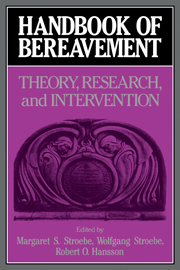Book contents
- Frontmatter
- Contents
- Contributors
- Preface
- Part I Introduction
- Part II The phenomenology and measurement of grief
- Part III Current theories of grief, mourning, and bereavement
- Part IV Physiological changes following bereavement
- 9 Biobehavioral consequences of loss in nonhuman primates: Individual differences
- 10 Neuroendocrine changes following bereavement
- 11 Bereavement, depressive symptoms, and immune function
- Part V The psychological, social, and health impacts of conjugal bereavement
- Part VI Grief reactions to different types of loss
- Part VII Coping, counseling, and therapy
- Part VIII Conclusions
- References
- Author index
- Subject Index
9 - Biobehavioral consequences of loss in nonhuman primates: Individual differences
Published online by Cambridge University Press: 04 May 2010
- Frontmatter
- Contents
- Contributors
- Preface
- Part I Introduction
- Part II The phenomenology and measurement of grief
- Part III Current theories of grief, mourning, and bereavement
- Part IV Physiological changes following bereavement
- 9 Biobehavioral consequences of loss in nonhuman primates: Individual differences
- 10 Neuroendocrine changes following bereavement
- 11 Bereavement, depressive symptoms, and immune function
- Part V The psychological, social, and health impacts of conjugal bereavement
- Part VI Grief reactions to different types of loss
- Part VII Coping, counseling, and therapy
- Part VIII Conclusions
- References
- Author index
- Subject Index
Summary
Psychoneuroimmunology contends that important relationships exist among behavior, the psychosocial environment, prior experience, and the immune system. These relationships are reflected, for example, in increased morbidity and mortality among the recently bereaved. The rapidly growing number of studies supporting psychosocial/immune relationships in the field of psychoneuroimmunology generally support the biopsychosocial model proposed by Engel (1977) many years ago. This model focused on the role of behavioral and psychosocial factors in the disease process. In spite of the many observations relating psychosocial factors to either disease processes or immunity (see Ader, Felten, & Cohen, 1991, for recent reviews of this rapidly progressing field), there remain questions and doubts regarding the role of these factors by many in the medical community (Angell, 1985). Much of the difficulty in drawing clear relationships between behavior and health outcome is related to the problems inherent in the study of human populations. Appropriate animal models can often resolve some of these dilemmas. This chapter focuses primarily on studies in nonhuman primates that have a particular relevance for loss and ensuing grief in humans. The reader is referred to chapter 11 in this volume by Irwin and Pike, which considers studies of immune function associated with loss in humans, and chapter 10, by Kim and Jacobs, which covers neuroendocrine function in humans during the bereavement process.
Although the relationship between bereavement and increased morbidity and mortality has been well documented (W. Stroebe & Stroebe, 1987; see also this volume), the biological mechanism(s) by which this experience leads to increased risk for medical illness is not clear.
- Type
- Chapter
- Information
- Handbook of BereavementTheory, Research, and Intervention, pp. 129 - 142Publisher: Cambridge University PressPrint publication year: 1993
- 8
- Cited by

